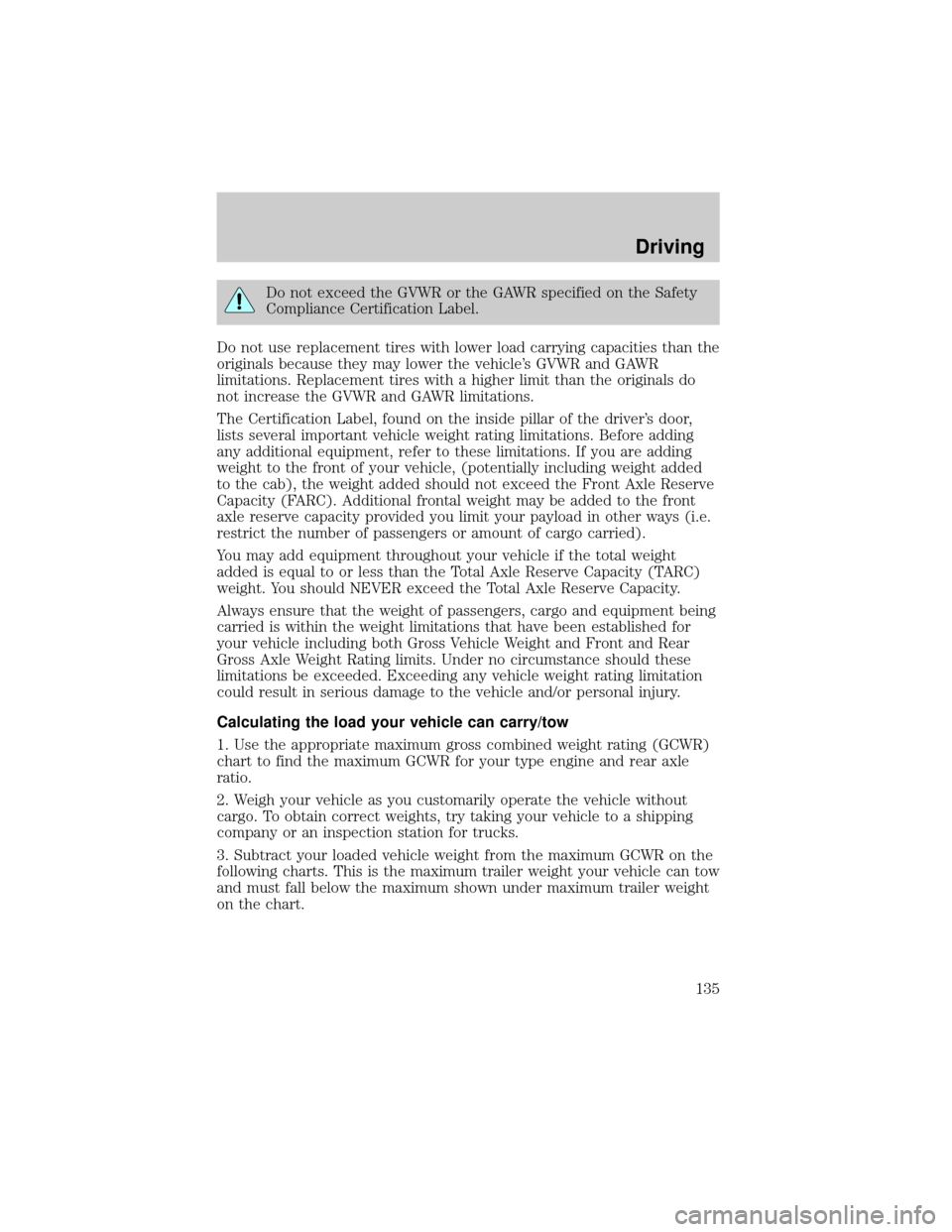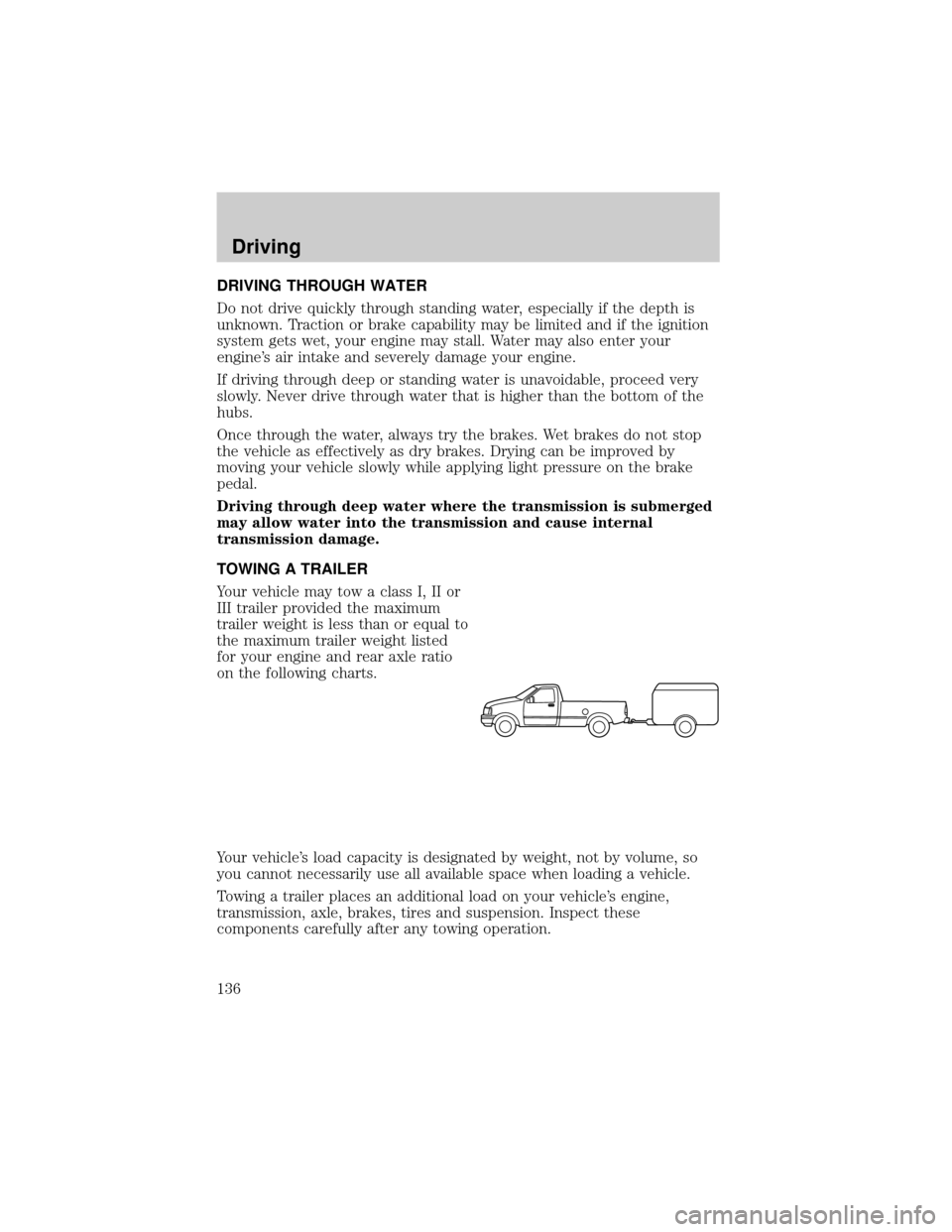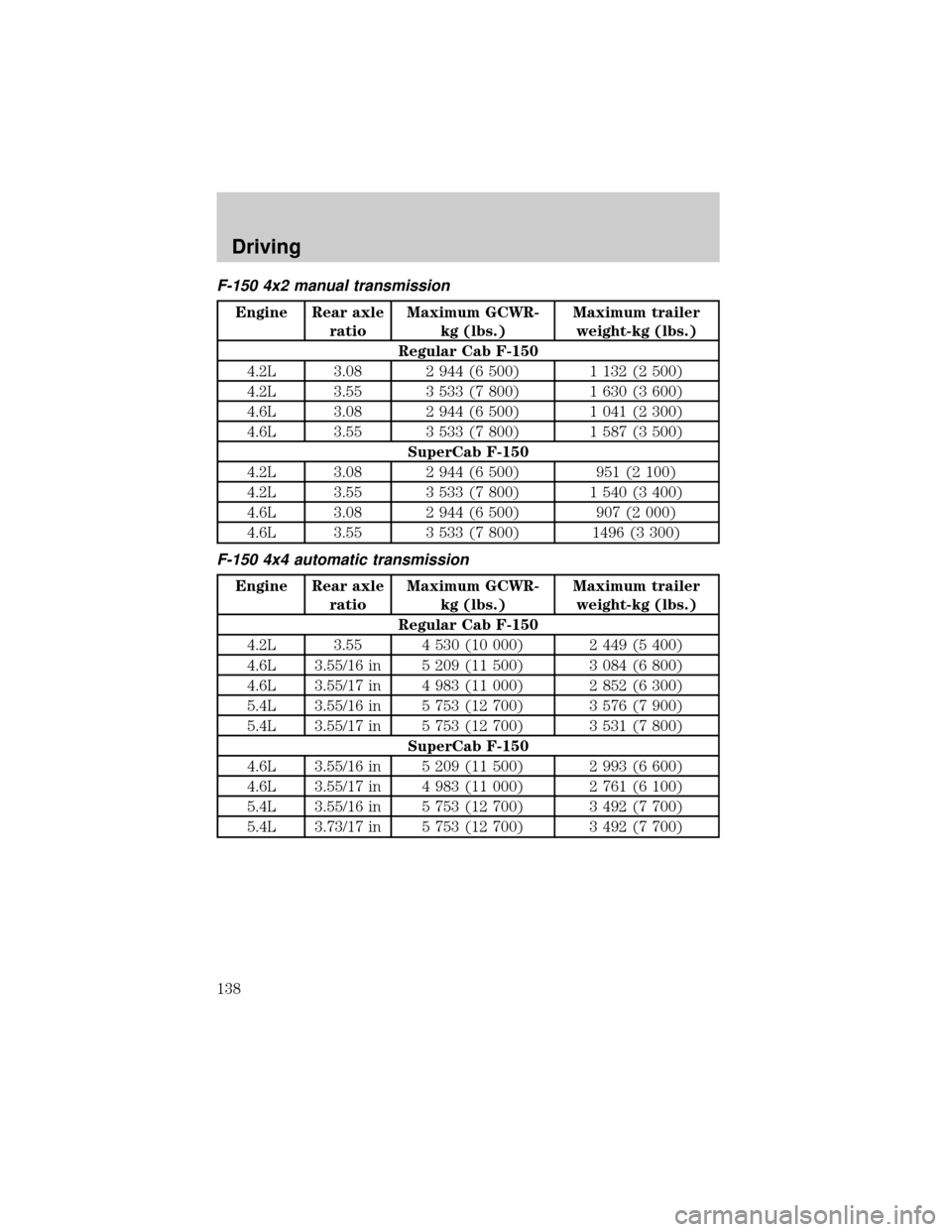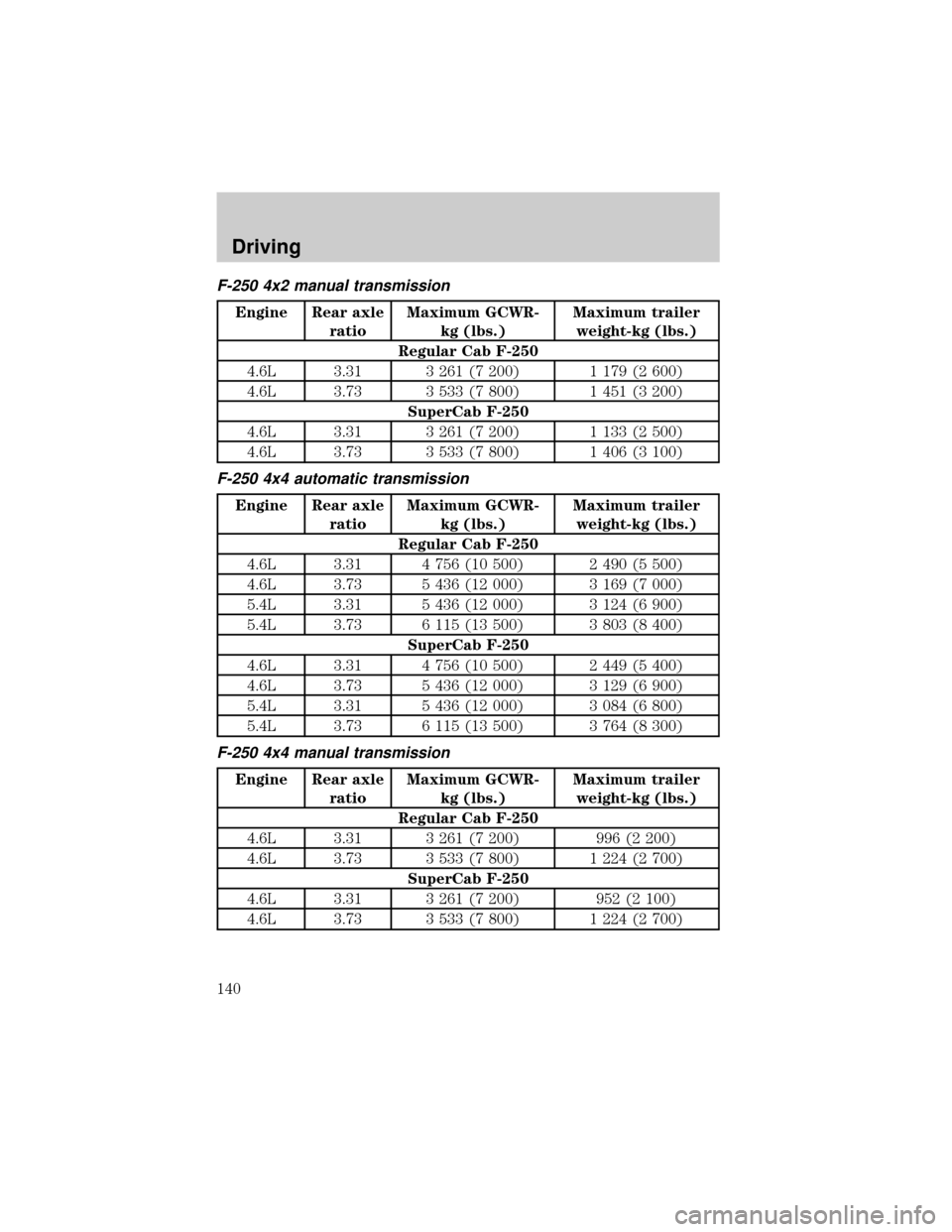Page 135 of 232

Do not exceed the GVWR or the GAWR specified on the Safety
Compliance Certification Label.
Do not use replacement tires with lower load carrying capacities than the
originals because they may lower the vehicle's GVWR and GAWR
limitations. Replacement tires with a higher limit than the originals do
not increase the GVWR and GAWR limitations.
The Certification Label, found on the inside pillar of the driver's door,
lists several important vehicle weight rating limitations. Before adding
any additional equipment, refer to these limitations. If you are adding
weight to the front of your vehicle, (potentially including weight added
to the cab), the weight added should not exceed the Front Axle Reserve
Capacity (FARC). Additional frontal weight may be added to the front
axle reserve capacity provided you limit your payload in other ways (i.e.
restrict the number of passengers or amount of cargo carried).
You may add equipment throughout your vehicle if the total weight
added is equal to or less than the Total Axle Reserve Capacity (TARC)
weight. You should NEVER exceed the Total Axle Reserve Capacity.
Always ensure that the weight of passengers, cargo and equipment being
carried is within the weight limitations that have been established for
your vehicle including both Gross Vehicle Weight and Front and Rear
Gross Axle Weight Rating limits. Under no circumstance should these
limitations be exceeded. Exceeding any vehicle weight rating limitation
could result in serious damage to the vehicle and/or personal injury.
Calculating the load your vehicle can carry/tow
1. Use the appropriate maximum gross combined weight rating (GCWR)
chart to find the maximum GCWR for your type engine and rear axle
ratio.
2. Weigh your vehicle as you customarily operate the vehicle without
cargo. To obtain correct weights, try taking your vehicle to a shipping
company or an inspection station for trucks.
3. Subtract your loaded vehicle weight from the maximum GCWR on the
following charts. This is the maximum trailer weight your vehicle can tow
and must fall below the maximum shown under maximum trailer weight
on the chart.
Driving
135
Page 136 of 232

DRIVING THROUGH WATER
Do not drive quickly through standing water, especially if the depth is
unknown. Traction or brake capability may be limited and if the ignition
system gets wet, your engine may stall. Water may also enter your
engine's air intake and severely damage your engine.
If driving through deep or standing water is unavoidable, proceed very
slowly. Never drive through water that is higher than the bottom of the
hubs.
Once through the water, always try the brakes. Wet brakes do not stop
the vehicle as effectively as dry brakes. Drying can be improved by
moving your vehicle slowly while applying light pressure on the brake
pedal.
Driving through deep water where the transmission is submerged
may allow water into the transmission and cause internal
transmission damage.
TOWING A TRAILER
Your vehicle may tow a class I, II or
III trailer provided the maximum
trailer weight is less than or equal to
the maximum trailer weight listed
for your engine and rear axle ratio
on the following charts.
Your vehicle's load capacity is designated by weight, not by volume, so
you cannot necessarily use all available space when loading a vehicle.
Towing a trailer places an additional load on your vehicle's engine,
transmission, axle, brakes, tires and suspension. Inspect these
components carefully after any towing operation.
Driving
136
Page 137 of 232
Do not exceed the GVWR or the GAWR specified on the Safety
Compliance Certification Label.
Towing trailers beyond the maximum recommended gross trailer
weight could result in engine damage, transmission/axle damage,
structural damage, loss of control, and personal injury.
Trailer towing tables
F-150 4x2 with automatic transmission
Engine Rear axle
ratioMaximum GCWR-
kg (lbs.)Maximum trailer
weight-kg (lbs.)
Regular Cab
4.2L 3.31 4 077 (9 000) 2 177 (4 800)
4.2L 3.55 4 530 (10 000) 2 582 (5 800)
4.6L 3.08 4 530 (10 000) 2 535 (5 600)
4.6L 3.55 5 209 (11 500) 3 261 (7 200)
5.4L 3.08 4 983 (11 000) 2 988 (6 600)
5.4L 3.55 5 753 (12 700) 3 757 (8 300)
SuperCab
4.2L 3.31 4 077 (9 000) 2 086 (4 600)
4.2L 3.55 4 530 (10 000) 2 540 (5 600)
4.6L 3.08 4 530 (10 000) 2 491 (5 500)
4.6L 3.55 5 209 (11 500) 3 171 (7 000)
5.4L 3.08 4 983 (11 000) 2 857 (6 300)
5.4L 3.55 4 983 (12 700) 3 628 (8 000)
Driving
137
Page 138 of 232

F-150 4x2 manual transmission
Engine Rear axle
ratioMaximum GCWR-
kg (lbs.)Maximum trailer
weight-kg (lbs.)
Regular Cab F-150
4.2L 3.08 2 944 (6 500) 1 132 (2 500)
4.2L 3.55 3 533 (7 800) 1 630 (3 600)
4.6L 3.08 2 944 (6 500) 1 041 (2 300)
4.6L 3.55 3 533 (7 800) 1 587 (3 500)
SuperCab F-150
4.2L 3.08 2 944 (6 500) 951 (2 100)
4.2L 3.55 3 533 (7 800) 1 540 (3 400)
4.6L 3.08 2 944 (6 500) 907 (2 000)
4.6L 3.55 3 533 (7 800) 1496 (3 300)
F-150 4x4 automatic transmission
Engine Rear axle
ratioMaximum GCWR-
kg (lbs.)Maximum trailer
weight-kg (lbs.)
Regular Cab F-150
4.2L 3.55 4 530 (10 000) 2 449 (5 400)
4.6L 3.55/16 in 5 209 (11 500) 3 084 (6 800)
4.6L 3.55/17 in 4 983 (11 000) 2 852 (6 300)
5.4L 3.55/16 in 5 753 (12 700) 3 576 (7 900)
5.4L 3.55/17 in 5 753 (12 700) 3 531 (7 800)
SuperCab F-150
4.6L 3.55/16 in 5 209 (11 500) 2 993 (6 600)
4.6L 3.55/17 in 4 983 (11 000) 2 761 (6 100)
5.4L 3.55/16 in 5 753 (12 700) 3 492 (7 700)
5.4L 3.73/17 in 5 753 (12 700) 3 492 (7 700)
Driving
138
Page 139 of 232
F-150 4x4 manual transmission
Trailer towing table (F-150 4x4 manual transmission)
Engine Rear axle
ratioMaximum GCWR-
kg (lbs.)Maximum trailer
weight-kg (lbs.)
Regular Cab F-150
4.2L 3.31 2 944 (6 500) 861 (1 900)
4.2L 3.55 3 533 (7 800) 1 451 (3 200)
4.6L 3.08 2 944 (6 500) 816 (1 800)
4.6L 3.55 3 533 (7 800) 1 406 (3 100)
SuperCab F-150
4.6L 3.08 2 944 (6 500) 771 (1 700)
4.6L 3.55 3 533 (7 800) 1 360 (3 000)
F-250 4x2 automatic transmission
Engine Rear axle
ratioMaximum GCWR-
kg (lbs.)Maximum trailer
weight-kg (lbs.)
Regular Cab F-250
4.6L 3.31 4 756 (10 500) 2 671 (5 900)
4.6L 3.73 5 436 (12 000) 3 350 (7 400)
5.4L 3.31 5 436 (12 000) 3 305 (7 300)
5.4L 3.73 6 115 (13 500) 3 938 (8 700)
SuperCab F-250
4.6L 3.31 4 756 (10 500) 2 625 (5 800)
4.6L 3.73 5 436 (12 000) 3 305 (7 300)
5.4L 3.31 5 436 (12 000) 3 259 (7 200)
5.4L 3.73 6 115 (13 500) 3 938 (8 700)
Driving
139
Page 140 of 232

F-250 4x2 manual transmission
Engine Rear axle
ratioMaximum GCWR-
kg (lbs.)Maximum trailer
weight-kg (lbs.)
Regular Cab F-250
4.6L 3.31 3 261 (7 200) 1 179 (2 600)
4.6L 3.73 3 533 (7 800) 1 451 (3 200)
SuperCab F-250
4.6L 3.31 3 261 (7 200) 1 133 (2 500)
4.6L 3.73 3 533 (7 800) 1 406 (3 100)
F-250 4x4 automatic transmission
Engine Rear axle
ratioMaximum GCWR-
kg (lbs.)Maximum trailer
weight-kg (lbs.)
Regular Cab F-250
4.6L 3.31 4 756 (10 500) 2 490 (5 500)
4.6L 3.73 5 436 (12 000) 3 169 (7 000)
5.4L 3.31 5 436 (12 000) 3 124 (6 900)
5.4L 3.73 6 115 (13 500) 3 803 (8 400)
SuperCab F-250
4.6L 3.31 4 756 (10 500) 2 449 (5 400)
4.6L 3.73 5 436 (12 000) 3 129 (6 900)
5.4L 3.31 5 436 (12 000) 3 084 (6 800)
5.4L 3.73 6 115 (13 500) 3 764 (8 300)
F-250 4x4 manual transmission
Engine Rear axle
ratioMaximum GCWR-
kg (lbs.)Maximum trailer
weight-kg (lbs.)
Regular Cab F-250
4.6L 3.31 3 261 (7 200) 996 (2 200)
4.6L 3.73 3 533 (7 800) 1 224 (2 700)
SuperCab F-250
4.6L 3.31 3 261 (7 200) 952 (2 100)
4.6L 3.73 3 533 (7 800) 1 224 (2 700)
Driving
140
Page 143 of 232

When towing a trailer:
²Use a lower gear when towing up or down steep hills. This will
eliminate excessive downshifting and upshifting for optimum fuel
economy and transmission cooling.
²Anticipate stops and brake gradually.
Exceeding the GCWR rating may cause internal transmission
damage and void your warranty coverage.
Servicing after towing
If you tow a trailer for long distances, your vehicle will require more
frequent service intervals. Refer to your Scheduled Maintenance guide
for more information.
Trailer towing tips
²Practice turning, stopping and backing up in an area before starting on
a trip to get the feel of the vehicle trailer combination. When turning,
make wider turns so the trailer wheels will clear curbs and other
obstacles.
²Allow more distance for stopping with a trailer attached.
²The trailer tongue weight should be 10±15% of the loaded trailer
weight.
²After you have traveled 80 km (50 miles), thoroughly check your
hitch, electrical connections and trailer wheel lug nuts.
²When stopped in traffic for long periods of time in hot weather, place
the gearshift in P (Park) (automatic transmissions) or N (Neutral)
(manual transmissions). This aids engine cooling and air conditioner
efficiency.
²Vehicles with trailers should not be parked on a grade. If you must
park on a grade, place wheel chocks under the trailer's wheels.
Launching or retrieving a boat
When backing down a ramp during boat launching or retrieval,
²Do not allow the static water level to rise above the bottom edge of
the rear bumper and
²Do not allow waves to break higher than 15 cm (six inches) above the
bottom edge of the rear bumper.
Driving
143
Page 145 of 232

4WD ± Electronic shift transfer case
1. Place transmission in N (Neutral).
2. Shift the transfer case to 2H (2WD high).
3. Lockout the center disconnect by capping off one of the front axle
vacuum motor lines. See your dealer for assistance.
4. Maximum speed is 56 km/h (35 mph).
5. Maximum distance is 80 km (50 miles).
If a distance of 80 km (50 miles) or a speed of 56 km/h (35 mph) must
be exceeded, you must disconnect the rear driveshaft. With the rear
driveshaft disconnected, the maximum speed is 88 km/h (55 mph) and
there are no mileage restrictions.
See your dealer for help with disconnecting the driveshaft.
SNOWPLOWING
Ford recommends the following specifications for low speed, personal
use snow removal:
²F-150/F±250 4WD Regular Cab long wheelbase
²4.6L or 5.4L engine
²Heavy duty service package
²Super engine cooling
²Heavy duty front suspension package
²Automatic transmission with auxiliary automatic transmission fluid
cooling
²All-terrain tires
Do not install a snowplow and plow with your vehicle until it has been
driven at least 800 km (500 miles).
Installing snowplow
Read the following instructions before installing a snowplow:
²Front GAWR must not exceed 63% of the GVW. Add ballast weight to
the back of the vehicle, if necessary. Refer to the Safety Compliance
Certification Label to find Front GAWR.
Driving
145